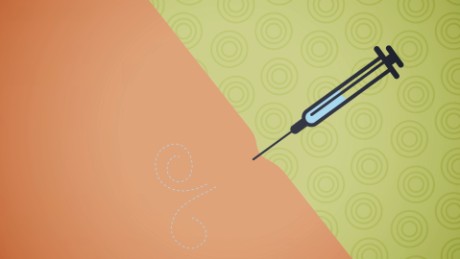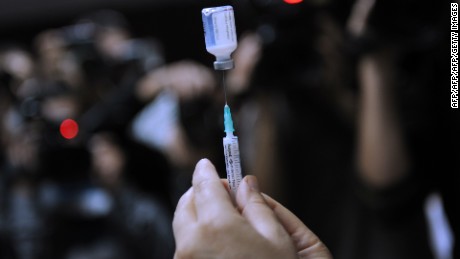Story highlights
- Shelley Johnson Carey's daughter caught measles in 1990 when she was 18 months old
- The toddler was a few months behind on her scheduled vaccines
This essay by writer Shelley Johnson Carey was originally published in 2015.
(CNN)Twenty-five years ago, I thought that a case of the measles was no big deal. Like my brother and sister before me, and my younger sister after, I had survived measles when I was about 7.
My clearest memory of that time was being kept a dark room for about a week and the bright blue helium-filled balloon my mother brought me. Months later, that puckered orb was still on display as a reminder of my victory over the measles. However, when my daughter Gillian -- then an 18-month-old toddler -- became ill with the measles in February 1990, my entire thinking changed forever about childhood diseases as a rite of passage.
At first, Gillian's hacking cough seemed like nothing more than the product of a mild cold that had gone straight to her chest. Her next symptoms, though, proved my theory wrong. The whites of her eyes turned bright red -- conjunctivitis? -- and her temperature shot to 104 degrees, then 105. Her little voice was hoarse. The most alarming thing was that my baby refused to drink anything. Usually, Gillian was a good eater who looked forward to her morning milk. Not that morning. I couldn't get her to swallow milk, baby acetaminophen or even apple juice, her favorite drink other than the Coca-Cola she was always trying to sip out of my glass.
"Definitely the measles," a doctor said after looking inside of Gillian's mouth. Her reddened eyes were swelling and she was increasingly listless. Her temperature reached 106, dangerously close to the point where she could suffer permanent brain damage. We had to act fast.
"You must go directly to the hospital," he told me. "Don't even stop by home. Go to the emergency room now."
So how did I get into a situation in which my baby was suffering from the measles years after a vaccine became available? A few months before, when Gillian should have gotten that vaccine, I decided against making an appointment. We were about to change to new insurance that would pay for all of her well-child health care expenses, including the vaccine that would prevent the measles. Although I had every intention of getting her shots up to date, I let life get in the way.
No harm, I thought. Measles hadn't been eliminated in the United States in 1990, but by then, most babies started MMR shots by 15 months. Neither my older daughter nor any of her day care friends had ever gotten the measles. I couldn't even remember the last time I'd even heard of a case. I figured we had plenty of time.
January came and went and I still hadn't gotten around to finding a pediatrician who took our new health plan. So there I was, that February morning, heading to the hospital with my blazing hot baby, trying to tempt her to drink milk, apple juice, anything.
"She needs intravenous fluid," a nurse told me. I remember her kind eyes, the only part of her face that wasn't covered by a white medical mask. "The doctor is in there," she pointed toward a closed door, "ready to put in an IV. Do you want to come in and hold her?" I looked at my baby girl and shook my head. I knew that Gillian would fight the procedure, and I was chicken. I didn't want to see her suffer. Two points against me for a Mother of the Year award. As I waited alone in the hall, I couldn't catch my breath. Guilt and fear consumed me.
As predicted, I heard her scream in pain. Soon after, the nurse put my daughter back in my arms, and then led us to where we would stay for the next few days. It was an isolation room, a small glass-enclosed space that held a crib, a television and a comfortable chair. Attached to the crib were bars to keep children from climbing out. The room reminded me of a zoo exhibit. The only thing missing was a sign saying, "Beware: human baby with measles." In that moment, I couldn't believe how my lack of awareness had led to such a frightening situation.
I wondered, how could I ever have thought that measles was no big deal?
With medication and fluid pumping into her small body, I could see my child returning. The nurse came to take her temperature, which had come down to a manageable 100 degrees within an hour. She was still weak and refusing baby food and bottles. She slept most of the two days we spent at the hospital. I sat up in the chair watching old sitcoms until I was bleary-eyed. In the darkness, I made a pact with God that if Gillian got better, I'd never again lose sight of my priorities.
On Saturday afternoon, a doctor knocked on the glass window and asked me to come outside to speak with him. "I'm the on-call pediatric resident this weekend," he explained, "but I've never had the measles so I hope that you don't mind if I don't come in." He looked sheepish. "I've read your daughter's records. Looks like you got here just in time. Now that everything is under control, she'll be fine."
Hearing his assurances, the tension I'd felt in my chest since Gillian's diagnosis began to dissipate. He was right. Gillian was getting back to her old self. I held her into the night, then put her back into the crib. When the nurse came in to check Gillian's liquid intake, I explained that she had taken only a couple of sips from my can of Coke. "I guess that is a liquid," the nurse said with a shake of her head as she noted Gillian's chart.
On Sunday, my little girl was discharged and we went home. A rash had spread across her body, but she seemed to feel better. Since my older daughter has been vaccinated, we had no fears of a family outbreak. But on Monday morning, the phone rang and a woman from the Maryland health department was on the phone. My next call was from the Centers for Disease Control and Prevention. I had to answer questions about Gillian's child care providers and whether any other children we knew had gotten sick. Thankfully, no more children we knew came down with it. We still don't know where Gillian was exposed.
Over the next few weeks, they regularly checked on Gillian's progress. After a week, she was almost back to normal and the week after that, she went back to day care. I was already back to work, so my mother took care of her during the day for most of those two weeks. Without her assistance, I would have had a real problem.
So what did I learn from this experience? I never again took my three children's good health for granted and found a wonderful pediatrician whom we kept until they aged out of his care. When I had my next child two years later, I followed his vaccine schedule faithfully. Gillian is now a teacher at an early childhood center; she has remained up to date on vaccines since, and receives a flu shot every year.
While many things have changed in the decades since her illness, there is still no cure for the measles. The recent measles outbreak that sprang from Disneyland made me think back to my many Disney park visits. I recall seeing hundreds of babies and toddlers happily exploring the Magic Kingdom from the comfort of their strollers. Not once did I consider how their health might be compromised simply by being at the "Happiest Place on Earth," and I bet their parents didn't either.
I hope that the current measles outbreak gives pause to the parents of little ones who reject vaccines. I wonder if those who choose not to vaccinate their children realize the gravity of the situation they might face. While every parent has the right to make personal decisions about their children's health care, parents need to know that not vaccinating their babies can also have scary and dangerous consequences.









